I started my day by checking out some photos on Etsy to try to figure out how I can take better photos. I have some tips: photos look best when taken in sunlight (although not directly in a sunbeam) and on a natural surface. I have a little space in my dining room that will do the trick. I hope to work on those photos again soon.
I finished working on my stepmom's scarf last night. I will take photos soon but I probably won't post them until she has received it. I have started to work on another one in the same pattern for sale on Etsy.
I also finished weaving my second-ever woven scarf! It is very short, and will probably be more of a neck decoration than something that keeps the neck warm. It was a bit of a challenge to finish this, as my loom fell apart as I was almost finished and I had to get out the hammer, nails and pliers in order to finish the job. This scarf is also going to be a present, this time to my mom, so I can't show you the whole thing yet. But here is a sneak preview:
I heat-set and removed the glue from two small glue resist pieces I did. They are drying and are not ready to be photographed yet. I also ironed the resists that I washed out yesterday. I am pretty pleased how they turned out. 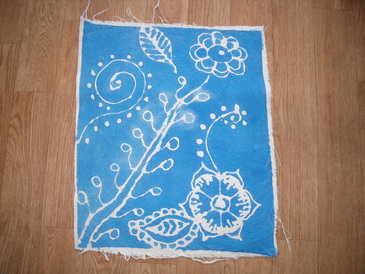 Based on henna designs. I learned not to scrub at the glue with a nail brush: this fades the fabric paint, which is why there are some faded bits around the leaves on the vine.  Cherry blossoms, a favorite motif of mine. 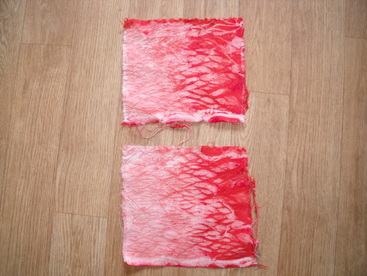 Pole wrap resist. This is apparently a type of shibori dyeing. I also did worked on some more glue resists to try with the textile paint, and I took one of the pole wrap cloths and tried a resist on that. Tomorrow I will put dye on top of it. I'm excited to see how it works. I also did a bit of snooping around last night (because with unschooling school is never in and school is never out) and found out that some of the physical resists I have been doing are shibori. I think I will take a shibori book out of the library, as there are many techniques I would like to try that I couldn't figure out from the internet.
I finished my yarn drawing. It looks a little better now that I've finished it. I have learned that I need to work on my negative space and my shading. I will probably do this by drawing more.
Yesterday was Labour Day, so I did roughly half a day of schooling. I would have done a full day but I wanted to spend some time with my husband, who doesn't get a lot of days off. So there was some decidedly not-working going on.
I started with the warm-up, as usual. It didn't go anywhere, which is becoming more frequent. The assignment was to get some sort of a box and put my "collection" in there, as a field journal. The problem was that I a) didn't have the type of box mentioned and b) that I don't have a collection. So that was that.
Next, I listened to my podcast as I wove. On the weaving front, my project is nearly finished! It will probably be a very short scarf as I don't think I factored in loom waste when I did my calculations. I may have mentioned that calculations are not my strong point. Anyway, the podcast was a continuation of the previous two day's podcasts, talking about Indian fabrics (mostly cotton) and their impact around the world). Eventually chintz got passe, because everyone had it, so no person of fashion would wear it. The next big thing in Indian cotton was Bengali muslin. At the time, Europeans could not make muslin, because they couldn't replicate the very finely spun thread used in muslin. It was apparently very difficult to weave because the thread was so fine. Muslin appeared in dresses with high waists (now known as Empire waists), because it looked like the clothes that ancient Grecian women wore in the art from that period. Since muslin is very fine, critics said that women were trying to replicate Grecian undress. Also fashionable at that time were cashmere shawls, with very beautiful patterns. In the beginning they tended to have a large plain field in the center and a decorated edge. Over time, the decoration came to take up most of the shawl. These could be draped around the shoulders in such a way that complemented the folds in the muslin dresses. These shawls were very expensive and it took a long time for them to go out of fashion. They were still fashionable in the Victorian period, where they became very long to coordinate with the silhouette of the day.
For my drawing assignment, I decided to draw a ball of fine yarn. Holy cow. When I try to draw stuff like this, it reminds me how far my drawing actually has to go. It was very frustrating and so far, looks nothing like a ball of yarn. It didn't help that I was looking at art magazines over the weekend with photorealistic drawings in them. I have to keep in mind that drawing isn't my ultimate medium and photorealism isn't my means of expression. That being said, I don't want to be an artist that can't draw so that's why I choose challenging projects like this. My last project was too easy and I finished it in 15 minutes. I suppose I could have made it more detailed, but I think I actually hit my limit of what I can currently do with my drawing. Drawing will be my next major subject after design, I think.
After that, I did surface design. Well, "did" is a relative term. I spent a lot of my time looking at the projects of the past few days trying to figure out what's next. I still haven't figured it out. Maybe they are finished. They are currently hanging in my dining room, where I can look at them and try to decide things. I also spent a fair amount of time flipping through my book, reading about different techniques that I might try. I decided to avoid discharges for the time being because you need a respirator, and I just don't feel like doing art that requires a respirator right now! I decided to do a resist with Elmer's school glue on some new pieces of cloth. However, when I got out my Elmer's glue, I saw that it was not school glue, and that it in fact would not work as a resist because it wouldn't wash out of the fabric. So I'll keep my eyes peeled for some cheap school glue when I go out today.
I skipped business study, although my husband and I discussed how I might do some more internet sales, and that I should think about what I want to sell online. I have a few items in my Etsy shop (none of them currently listed) and I think I will try to sell those again, but they need better photos and it's not the kind of stuff I want to spend the rest of my life making. I might start a new shop in conjunction with my current one. But first I have to find my camera parts!
My design study was a bit all over the place. I started by finishing the previous chapter on form. I actually didn't have much left in that chapter, so now I think it's odd that I stopped what I did. I read about form in three dimensional design, much of which is the same as two-dimensional design. Balance is a little different because things have to look balanced from all different directions. Asymmetrical balance is most common. The scale of 3-D work is important-- it could be a tiny thing that could be held in the palm of the hand, or it could be large enough to be walked on, or so incredibly huge it can be seen from far away. Movement can be quite different because kinetic sculpture is possible. The next section that I started on (but didn't get very far in) was about line. I am quite excited about this chapter, as I am really interested in how line can be used in surface design. The characteristics of line are measure (the length and width of the line), type (straight, curved, or angular), direction (which way the line moves on the surface; for example, you could have a zig-zag line that curved over the surface of the work), and location (where on the surface the line is, and how that affects our perception of space, perspective, and so on.) That's as far as I have gotten.
In my personal projects, I have started to knit a scarf for a birthday present for my stepmom. I had a pattern, tried it, scrunched it up and threw it away, and made my own pattern. It's my first lace pattern, and I am pretty impressed with myself considering that I have only made 1 1/2 lace projects before. I can't post the photos yet because my stepmom might be reading this, but after she receives it I will post them.
Today might have been one of those days that people would point to as an example of why unCollege doesn't work. Which is silly, because I remember quite a bit more noodling around from my traditional college days. It would take three hours to write a paragraph for a paper because I was screwing around on Facebook and Youtube most of the time. So I was actually quite a bit more productive today than I would have been back in my undergrad days, even though I was feeling really lazy and didn't accomplish much compared to the other days.
Today's warm-up was a complete bust, as the assignment was to go through your best friend's stash. This would not be possible for me today, and even if it was I would feel pretty uncomfortable about it. I don't like it when people go through my things, so why would it be okay for me to do it to someone else? So I knitted instead. Being super-unproductive, I knitted about 4 rows before I quit.
I worked on my weaving while I listened to today's podcast. It was a continuation of yesterday's and talked about the rage for chintz (in the traditional sense of painted cotton) in Europe. It was crazy-popular in England, although it was relatively inexpensive so people who were trying to show off how rich they were would wear silk underneath. It was also very popular in Holland. It didn't make much of a splash in Italy or France. In England, rich women would give chintz clothes to their servants, so people complained that they couldn't tell what class people were by looking at them (the horror!). It started out being popular for bedspreads and that sort of thing, but then made its way to fashion, which led some to gripe about people wearing their bedsheets. Because it was so popular and relatively inexpensive, local cloth manufacturers were having a difficult time. Most cloth manufacturers in England were producing wool and linen cloth, which are much more difficult to clean than cotton. So the importation of chintz was outlawed. People were very creative in finding ways around the laws so chintz continued to be worn. Eventually European importers began to request certain themes or motifs on their chintz, which the Indian manufacturers would carry out. For example, trees were very popular in Holland.
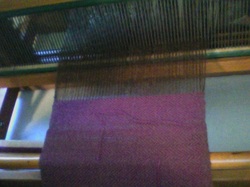 My weaving, which is not chintz. 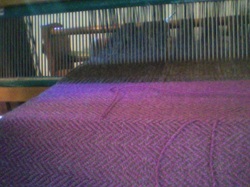 Note the herringbone pattern. I should also mention that I actually taught myself how to read a weaving pattern today. Mostly. Next I worked on drawing. This was one of the assignments where I felt I was the laziest. I set up a very simple still life. Very simple. I think it took me 20 minutes to draw it. My last drawing took about five hours. 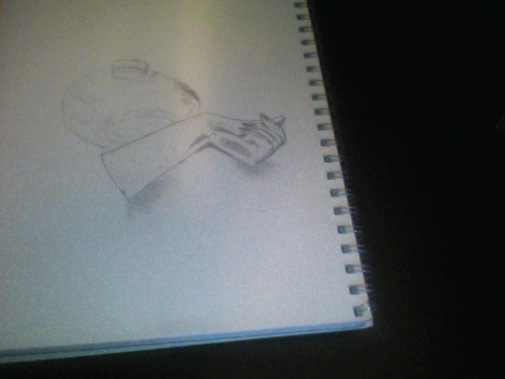 I promise I will take better photos one day. I want to scan this, but the scanner isn't talking to my computer. This should be indicative of my general technology-savviness. I studied my design book after that. This unit was about other principles in 2-D design (harmony being the one that I looked at yesterday). I looked at variety, the counterpart to harmony. This could involve contrast, meaning opposition or dissimilarity. Contrast could be in color, value, or placement. Elaboration of an area that lacked visual interest is another way of achieving variety. Finally, one must take into account the dualism of harmony and variety. You could, for example, achieve harmony by repeating shapes, and variety by making those shapes different colors. Another principle is balance, which is what we perceive should happen with the objects in the work. For example, a picture of a ball at the top of a painting gives a sense of tension, as we expect the ball to fall down. Additionally, the way we perceive things, it doesn't look right when the mat around the painting is equal on all sides. Usually the bottom part will be a bit larger, which makes things seem more balanced. There are different kinds of balance: symmetrical balance, in which the two halves of the work mirror each other; approximate symmetrical balance, where equal visual weights are on both halves of the work, even though those halves aren't identical; and radial balance, where the visuals radiate out from a certain point on the work; asymmetrical balance, in which colors, shapes, lines, and negative area balance each other out (this I know when I see but don't know how to reproduce it myself). Next I looked at proportion, which is the relationship in placement in a work. The golden mean is a part of that, although I must admit that I don't really understand the golden mean and how it works. I understand that there is some sort of ratio that the shapes have to each other, but that's the extent of what I understand. Proportion could also mean the proportion of the work itself to the surrounding areas, or how much room the subject(s) of the painting take up within the picture frame. In ancient art, the most important figure would be the largest, with other figures smaller. Dominance is another principle. Dominance occurs when a figure or shape dominates the surrounding space, whether through size, color, value, or something else. Movement is the direction of the viewers eyes to different parts of the work. Artists can manipulate what order the viewer looks at the image in by placing points of interest in different places on the work. Economy is another principle of design, where the artist seeks to eliminate that which is unnecessary or confusing. Finally, there is the problem of space: what sort of visual plane the artist wants to appear on the work. A 2-D work with a flat plane is referred to as decorative and one with a deep plane is called three-dimensional or plastic.
Next, I worked on the dreaded task of removing the dye from my sample cloths. Some of the overdyes ended up being quite interesting. 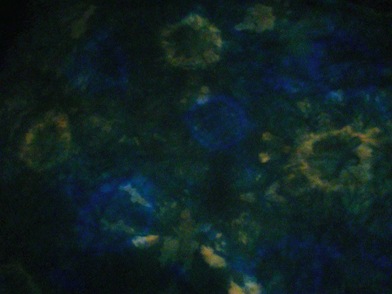 Tie-dye without stones 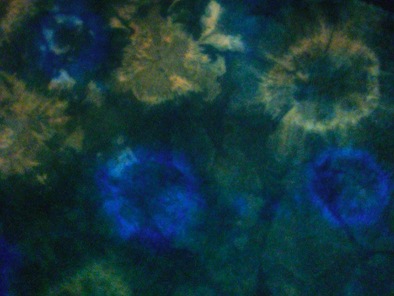 Tie-dye with stones 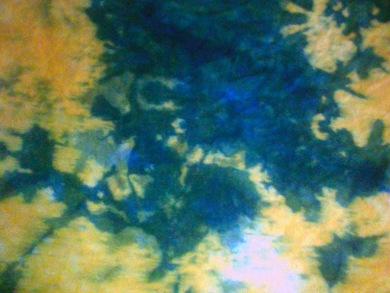 Scrunching 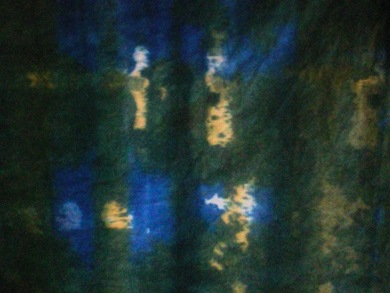 Pleated 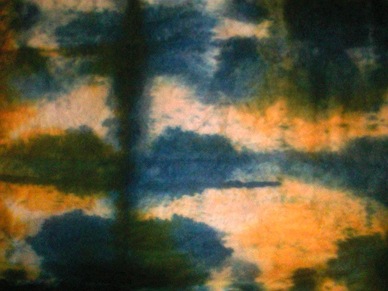 Folded. I like that this one kind of looks like ikat. Finally, I worked on my business study. I am still trying to come up with numbers for my start-up costs. It is hard to get some straight answers about how much something will cost me. I'm also trying to figure out if I need a business license. I apparently don't need to be a citizen to sell at the Saturday market, but if I make over $15,000 a year I need a business license, and I don't know the legalities of that. I guess it's a good thing that I have to figure all that stuff out before I can get started and cost myself a pile of money or accidently break rules. But I've decided to figure out start-up and ongoing costs before I move to the next thing in the book. Otherwise I will get too confused. I really hate trying to figure money out but I also hate working for other people so I guess I'd better get over that!
I have filled in an application to volunteer at the Museum of Contemporary Craft. I will most likely be handling transactions or directing customers, but it will give me the chance to see how a gallery works. Besides, it's my favorite gallery in town. So I will keep you posted on my progress.
Yesterday, I forgot to mention that I got my very own unCollege student ID card! My wonderful friend Melanie Wallace, who has a laminator, made it for me. Thanks Mel!
|
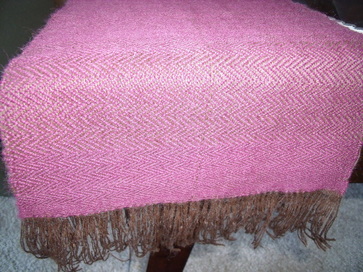
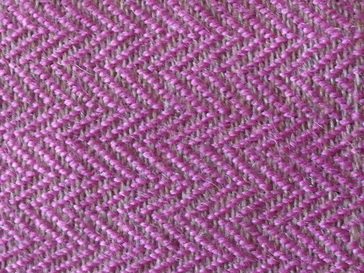















 RSS Feed
RSS Feed
